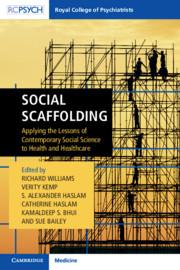29 results
Interventions to reduce self-harm on in-patient wards: systematic review
-
- Journal:
- BJPsych Open / Volume 7 / Issue 3 / May 2021
- Published online by Cambridge University Press:
- 16 April 2021, e80
-
- Article
-
- You have access
- Open access
- HTML
- Export citation
Building improvement capability in frontline staff: a UK perspective
-
- Journal:
- BJPsych International / Volume 17 / Issue 4 / November 2020
- Published online by Cambridge University Press:
- 10 June 2020, pp. 76-79
- Print publication:
- November 2020
-
- Article
-
- You have access
- Open access
- HTML
- Export citation
Copyright page
-
- Book:
- Social Scaffolding
- Published online:
- 14 June 2019
- Print publication:
- 04 July 2019, pp iv-iv
-
- Chapter
- Export citation
Index
-
- Book:
- Social Scaffolding
- Published online:
- 14 June 2019
- Print publication:
- 04 July 2019, pp 341-352
-
- Chapter
- Export citation
Chapter 5 - The Relevance of Social Science to Improving Health and Healthcare
- from Section 1 - Schooling
-
-
- Book:
- Social Scaffolding
- Published online:
- 14 June 2019
- Print publication:
- 04 July 2019, pp 40-42
-
- Chapter
- Export citation
Section 2 - Scoping
-
- Book:
- Social Scaffolding
- Published online:
- 14 June 2019
- Print publication:
- 04 July 2019, pp 43-128
-
- Chapter
- Export citation
Foreword
-
- Book:
- Social Scaffolding
- Published online:
- 14 June 2019
- Print publication:
- 04 July 2019, pp xi-xii
-
- Chapter
- Export citation
Section 5 - Sustaining
-
- Book:
- Social Scaffolding
- Published online:
- 14 June 2019
- Print publication:
- 04 July 2019, pp 329-340
-
- Chapter
- Export citation
Section 1 - Schooling
-
- Book:
- Social Scaffolding
- Published online:
- 14 June 2019
- Print publication:
- 04 July 2019, pp 1-42
-
- Chapter
- Export citation
Contents
-
- Book:
- Social Scaffolding
- Published online:
- 14 June 2019
- Print publication:
- 04 July 2019, pp v-vi
-
- Chapter
- Export citation
Note
-
- Book:
- Social Scaffolding
- Published online:
- 14 June 2019
- Print publication:
- 04 July 2019, pp xiii-xiv
-
- Chapter
- Export citation
Chapter 26 - Synthesising Social Science into Healthcare
- from Section 4 - Scaffolding
-
-
- Book:
- Social Scaffolding
- Published online:
- 14 June 2019
- Print publication:
- 04 July 2019, pp 257-273
-
- Chapter
- Export citation
Section 3 - Sourcing
-
- Book:
- Social Scaffolding
- Published online:
- 14 June 2019
- Print publication:
- 04 July 2019, pp 129-212
-
- Chapter
- Export citation
Section 4 - Scaffolding
-
- Book:
- Social Scaffolding
- Published online:
- 14 June 2019
- Print publication:
- 04 July 2019, pp 213-328
-
- Chapter
- Export citation
Contributors
-
- Book:
- Social Scaffolding
- Published online:
- 14 June 2019
- Print publication:
- 04 July 2019, pp vii-x
-
- Chapter
- Export citation
Chapter 30 - Smithtown as Society
- from Section 4 - Scaffolding
-
-
- Book:
- Social Scaffolding
- Published online:
- 14 June 2019
- Print publication:
- 04 July 2019, pp 312-328
-
- Chapter
- Export citation

Social Scaffolding
- Applying the Lessons of Contemporary Social Science to Health and Healthcare
-
- Published online:
- 14 June 2019
- Print publication:
- 04 July 2019
Diagnosis and treatment: Are psychiatrists choosing wisely?
-
- Journal:
- BJPsych Advances / Volume 23 / Issue 1 / January 2017
- Published online by Cambridge University Press:
- 02 January 2018, pp. 9-15
- Print publication:
- January 2017
-
- Article
-
- You have access
- HTML
- Export citation
诊断与治疗:精神科医生是否做出明智选择 [translation of “Diagnosis and treatment: Are psychiatrists choosing wisely?” by Zhao Zhenru, Roger Ho Chun Man]
-
- Journal:
- BJPsych Advances / Volume 23 / Issue 1 / January 2017
- Published online by Cambridge University Press:
- 02 January 2018, E1
- Print publication:
- January 2017
-
- Article
-
- You have access
- Export citation
Cost and carbon burden of long-acting injections: a sustainable evaluation
-
- Journal:
- BJPsych Bulletin / Volume 40 / Issue 3 / June 2016
- Published online by Cambridge University Press:
- 02 January 2018, pp. 132-136
- Print publication:
- June 2016
-
- Article
-
- You have access
- Open access
- HTML
- Export citation



